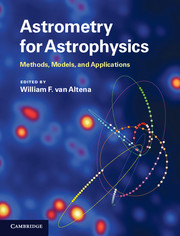Book contents
- Frontmatter
- Contents
- List of contributors
- List of acronyms
- Preface
- Part I Astrometry in the twenty-first century
- Part II Foundations of astrometry and celestial mechanics
- Part III Observing through the atmosphere
- 9 The Earth's atmosphere: refraction, turbulence, delays, and limitations to astrometric precision
- 10 Astrometry with ground-based diffraction-limited imaging
- 11 Optical interferometry
- 12 Radio astrometry
- Part IV From detected photons to the celestial sphere
- Part V Applications of astrometry to topics in astrophysics
- Index
- References
9 - The Earth's atmosphere: refraction, turbulence, delays, and limitations to astrometric precision
from Part III - Observing through the atmosphere
Published online by Cambridge University Press: 05 December 2012
- Frontmatter
- Contents
- List of contributors
- List of acronyms
- Preface
- Part I Astrometry in the twenty-first century
- Part II Foundations of astrometry and celestial mechanics
- Part III Observing through the atmosphere
- 9 The Earth's atmosphere: refraction, turbulence, delays, and limitations to astrometric precision
- 10 Astrometry with ground-based diffraction-limited imaging
- 11 Optical interferometry
- 12 Radio astrometry
- Part IV From detected photons to the celestial sphere
- Part V Applications of astrometry to topics in astrophysics
- Index
- References
Summary
Introduction
The Earth's atmosphere imposes several limitations on our ability to perform astrometric measurements from the ground in both the optical and radio regions of the spectrum. First, we are limited to wavelengths where the absorption is not too great, i.e. the broad optical region from the ultraviolet to the near-infrared, scattered regions in the infrared and broad regions at radio wavelengths. The fundamental limitations imposed by the atmosphere are different in the optical and radio and in this chapter we will deal with those important for the optical; the radio part is largely dealt with in Chapter 12 on radio interferometry, except for a summary given here on the precision limitations imposed by the atmosphere. The second problem created by observing through the atmosphere is refraction of the light waves as they pass through different levels of the atmosphere. If it were only refraction through a stable medium, the problem would be very simple; however, the atmosphere is a turbulent medium that causes variations in the amount of refraction both spatially and temporally and it therefore limits the precision and accuracy of our observations. In this chapter we will deal with both effects using the developments in Schroeder (1987, 2000) as the basic reference.
Refraction through a plane-parallel atmosphere
When we are dealing with relative positions in fields of view less than several degrees, it is sufficient to adopt a plane-parallel atmosphere for the model. In cases where we need to consider the total displacement, such as with meridian circles, it is necessary to adopt atmospheric models that are substantially more complicated, such as those developed by Garfinkel (1967) and Auer and Standish (2000). For the purposes of this chapter we can safely use the plane-parallel atmosphere.
- Type
- Chapter
- Information
- Astrometry for AstrophysicsMethods, Models, and Applications, pp. 121 - 141Publisher: Cambridge University PressPrint publication year: 2012



